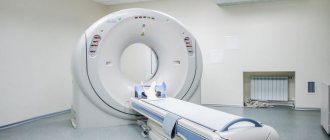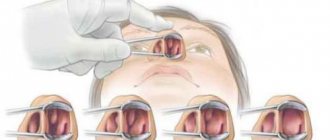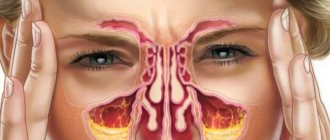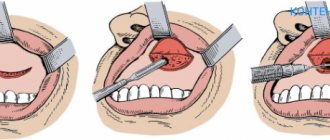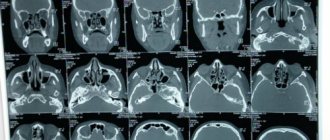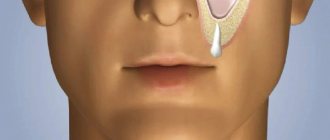Otolaryngologists often prescribe x-rays of the nasal sinuses. This is a procedure that will allow the doctor to detect various changes and pathologies in this area. It is prescribed to adults quite often, but when studying children, they prefer other methods. This is due to the use of Y-rays, which translucent tissue and have a possible negative effect on the child’s body. Although sometimes an x-ray is required.
Inflammation of the sinuses
This diagnostic method began to be used in medicine quite a long time ago - more than a century ago. The ability of tissue and liquids to retain X-rays is the basis of the study. It is quite easy for a specialist to evaluate the resulting images; he examines the darkening and discoloration of organs. Look at the photo to see what the pictures might look like.
General description of the disease
The sinuses are cavities of the cranial bone that are filled with air and covered with mucous membrane. The cells that are located there form a thin secret film in which, for example, when particles of dust or dirt enter, unwanted pathogens are trapped.
On the surface of the cells of the mucous membrane there are small mobile hairs that continuously transport the secret film towards the nasal cavity, from there to the throat, thus inhaled dust and dirt are removed from the sinuses of the nose, after which they are swallowed along with a thin, imperceptible and imperceptible secret.
When the mucous membrane becomes inflamed, such as during a cold, this process can stop, causing the mucous membrane to produce much more secretions than usual. This, in turn, can cause the small connecting channels between the nose and paranasal sinuses to begin to swell and become clogged.
The sinuses will no longer be properly ventilated, and the secretions may move more slowly. Thus, an ideal breeding ground is formed for pathogens that provoke the development of sinusitis. You can see what sinusitis looks like in the picture.
When are tests ordered?
The appointment is recommended for patients who suspect the development of inflammatory processes in the paranasal sinuses or who are suspected of getting foreign objects.
Using an image, you can determine the type of sinusitis, which can be classified by location:
- The well-known sinusitis is inflammation of the upper jaw.
- Inflammation in the frontal part is called frontal sinusitis.
- Ethmoitis - appears on the image as darkening of the mastoid cells.
- The affected area of the sphenoid bone is the sphenoid.
Depending on the diagnosis, treatment and possibly additional studies are prescribed.
Sinusitis and healthy sinuses
Reasons for the development of sinusitis
The most common cause of sinusitis is the common cold. This disease almost always develops against a background of weakened immunity in combination with existing infections, viruses and bacteria in the body. Most often, this disease is caused by viruses rather than bacteria. Bacterial sinusitis is often caused by pneumococci, staphylococci and streptococci. Fungi are less common causative agents.
Experts say that the mucous membrane of the sinuses actually almost always fights dangerous microbes. This is especially true in cases when it becomes inflamed. However, the person does not notice this. Whether sinusitis will develop or not depends on the strength of the body’s protective functions and the properties of the main pathogen.
The development of sinusitis can also be contributed to by an allergic runny nose, which can be acute or chronic. You can see more clearly in the picture above what sinusitis looks like.
There is also dental sinusitis, which develops due to existing problems with the teeth, for example, an infection in the root of the tooth, root granulomas or a cyst of the jaw cavity after tooth extraction. In this case, microbes from the upper jaw enter the adjacent sinuses, which leads to the development of sinusitis.
In some people, the so-called ventilation of the sinuses is completely disrupted, which is why the outflow of secretions is constantly disrupted. This can occur as a result of benign growth of the mucous membrane, which is called “nasal polyps”. This also occurs due to large nasal conchas, disruption of the structure of the nasal septum, as well as existing tumors. Such anatomical features sometimes contribute to the development of sinusitis or prevent its elimination.
Features of radiographic examination of the sinuses
To carry out radiography, an adult and a child do not need to carry out preliminary preparation; it is enough to get a referral from a doctor and go for diagnostics. The only condition is that you need to remove all metal products, prostheses and glasses. When metal interacts with gamma rays, it distorts the image.
An X-ray of the nasal sinuses is taken in two projections - occipito-frontal and occipito-mental. The procedure does not take more than two minutes. The patient must take a vertical position during the procedure. The upper part of the patient's torso is covered with a thick apron. The picture is taken while the patient is holding his breath.
The radiation dose from X-rays is minimal, but it is still prescribed with caution to children and pregnant women. During pregnancy, this procedure is prescribed only if absolutely necessary, as it is considered unsafe for the health of the child. During the period of intrauterine development, it is undesirable for a child to be exposed to even minimal exposure to X-ray waves, as this can cause the formation of defects.
In preschool and primary school age, the influence of X-rays negatively affects the formation of bone tissue, so if this procedure can be avoided, doctors do everything possible.
As a result of the study, an image is obtained that must be interpreted by a radiologist. First, the photograph is developed, then dried and studied.
Clean, even boundaries and areas without darkening indicate a positive course of the treatment process. If during decoding questions arise related to image quality, you can use a more advanced diagnostic method - computed tomography or MRI. And as an alternative to x-rays, choose contrast radiography.
Symptoms of sinusitis
You can visually see in the picture what sinusitis looks like. But the typical symptoms of the disease are:
- aching headaches;
- secretion flowing into the throat;
- purulent secretion;
- impaired sense of smell;
- nasal congestion;
- toothache in the upper jaw;
- sometimes pain when touching the nose.
The most common symptoms are headaches and pain in the face, and the location depends on which sinuses are inflamed. If inflammation is observed in the frontal sinuses, then the pain is concentrated mainly on the forehead and eyes. Maxillary sinuses (sinusitis itself) provoke pain on the cheekbones and upper jaw. If the sinuses deep in the nose are inflamed, headaches may occur.
At the same time, the person feels strong pressure on the forehead and cheekbones. These symptoms are usually worsened by bending over, coughing, sneezing, or hitting. The affected areas on the face above the corresponding sinuses may become swollen. Complaints are often limited to just one symptom. Many patients notice that there is always a secretion in the throat. At the same time, the patient begins to have difficulty distinguishing odors.
In young children, it is quite common for the infection to spread to the ears, causing inflammation.
The signs of chronic sinusitis are more pronounced than the symptoms of acute inflammation. Patients may feel weakened, experience strong pressure on the affected sinuses, constantly suffer from headaches, have difficulty breathing through the nose, and cannot perceive any odors at all. Some people experience constant swelling of the mucous membrane in the throat.
The photo will show in more detail what sinusitis looks like on an x-ray.
Important symptoms to watch out for
Unfortunately, sinus problems can occur suddenly even in healthy people. There can be a huge variety of reasons, ranging from hypothermia to injuries and infectious diseases.
If these symptoms appear, you should consult a therapist or ENT specialist:
- intense headache;
- temperature increase;
- frequent nosebleeds;
- after an acute respiratory infection, pain in the sinuses;
- stuffy nose;
- prolonged nasal discharge.
Establishing diagnosis
The diagnosis of “sinusitis” can be made by both a general practitioner and an otolaryngologist. First of all, specialists take into account typical symptoms. The doctor can also examine the mouth and throat for existing purulent collections on the back walls of the pharynx. This may indicate acute sinusitis. All this will be clearly visible on the X-ray image, where both the doctor and the patient will see what sinusitis looks like.
And after a blood test, additional information may be provided. Thanks to this, it becomes clear in what form the disease develops.
To recognize the chronic form, the doctor examines the nasal sinuses using a special optical instrument with a mirror and a thin endoscope. In this way, all mucous membranes can be easily examined. When inflamed, they become red and swollen. In addition, the doctor can see the accumulated, possibly purulent, secretion. Thanks to such studies, nasal polyps, tumors of the mucous membrane, and a deviated nasal septum are often detected. In some cases, for example, in case of human immunodeficiency, the doctor takes a swab of nasal secretions to identify pathogens and prescribe appropriate antibiotics. You can see in the photo above what sinusitis looks like in adults on an X-ray.
Treatment methods
If sinusitis provokes severe and constant pain, or if it has manifested itself more than once, then this is a reason to consult a doctor as soon as possible. You can treat this disease at home. To do this, it is necessary to periodically rinse the nose with physiological and saline solutions. Such compositions, as a rule, cleanse the mucous membrane and promote the outflow of secretions. However, it is worth paying attention to the fact that such solutions can irritate the mucous membrane, which interferes with treatment for many patients.
Treatment at home
Another home therapy method is vapor inhalation. To carry out this procedure you will need hot water. However, when inhaling vapors, you must be very careful not to scald your mucous membranes. It is recommended to add chamomile, essential oils or sea salt to the water.
Herbal remedies can also help in the fight against sinusitis. For example, gentian root or eucalyptus are ideal for treating acute sinusitis. However, sometimes these herbs can cause stomach problems. Therefore, before treatment, it is necessary to consult with a specialist to avoid side effects, especially in cases where sinusitis is observed in a child. You can see what it looks like on an X-ray with a pediatrician after an examination.
Pharmacy products
You can also purchase special drops or nasal spray at the pharmacy, which contain the active substance xylometazoline or oxymetazoline. The most suitable for the nasal mucosa are preparations without benzalkonium chloride. It is important to note that they are used for treatment for a maximum of one week, otherwise addiction or even dependence may occur.
As soon as the effect of the drug decreases, the nasal mucosa begins to swell even more, which forces the patient to use the drug again. At the same time, the mucous membrane may dry out. For this reason, the patient must consult with his or her physician to select and use a specific drug.
Other medications that are prescribed only by a specialist can also be used.
Carrying out the operation
If treatment with drugs and folk remedies does not produce any results, then surgical intervention is required after the doctor examines what sinusitis looks like on an x-ray, an example photo was given above.
If necessary, septoplasty is performed during surgery, which straightens or widens the nasal passage, and nasal polyps are removed. These actions are usually carried out using special instruments that penetrate the nasal cavity. External incisions are quite rare in practice today.
What does an X-ray of the nasopharynx show in children?
X-rays of the nose and throat in children do not provide much information. With its help you can identify the following features:
- enlarged pharyngeal tonsils;
- accumulation of pus.
The study is rarely used, as it is characterized by high error. With enlarged tonsils, a purulent complication is often observed. When taking an x-ray, enlargement of the pharyngeal tonsils is visualized due to the presence of purulent contents.
Photo: X-ray of the nasopharynx – cyst in the left maxillary sinus
You should not rely on the results of radiography. The examination will add one or two degrees to the pathology. Based on X-ray diagnostics, it is difficult to answer the question of how to cure adenoids without surgery, since examination is not enough to study the structure of the tonsils.
When it is necessary to determine how to treat adenoids without surgery in a child, doctors perform an external examination, a probe review of the condition of the upper respiratory tract, and do laboratory blood tests.
X-ray diagnostics of adenoids in children with 3rd degree enlargement of the pharyngeal tonsils shows only a general increase in the tissues of the nasopharynx. The information content of the survey is low, so it is practically not used.
